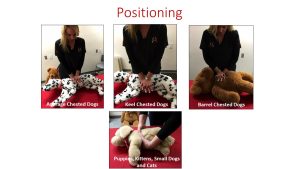ADV- Lesson 3- Chest Compressions

The shoulders of the compressor should be directly above the hands. If the height of the table makes it impossible to keep the elbows locked while doing compressions, the compressor should use a stool, climb on the table with the animal or place the animal on the floor. Always lock your elbows and use your core muscles rather than your biceps or triceps. This will reduce fatigue and maintain optimal compression force. Hands should be placed one over the other, locking fingers if need be.
Note that in the diagram, dogs and cats are positioned differently for compressions based on their size and shape of their chest. Compressions in average-to-large sized dogs should be done with the hands placed over the widest portion of the animal’s chest, compressions in keel chested dogs should have the hands placed directly over the heart close to the sternum, barrel chested dogs should be placed on their backs; hands are placed in the middle of the sternum for chest compressions and in cats and small dogs wrap hands around the chest and compress by squeezing thumb and fingers together.
- Chest compressions are done with the animal lying on the right side (or on back for barrel chested animals)
- Chest should be compressed at 1/2-1/3 the width of the chest
- Compression rate should be 100-120 BPM
- Make sure to allow the chest to fully recoil between compressions
- Compression ratio is 30 compressions to 2 breaths for manual CPR or continuous chest compressions with 1 breath every 6 seconds for ventilated CPR.
